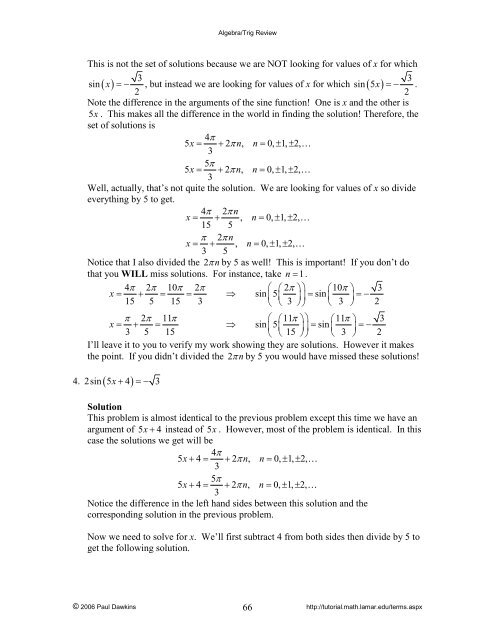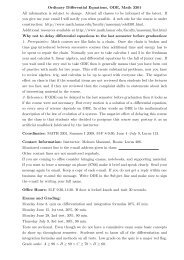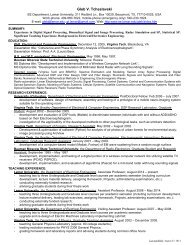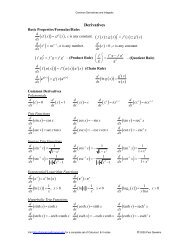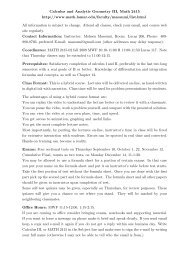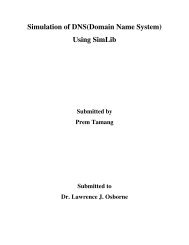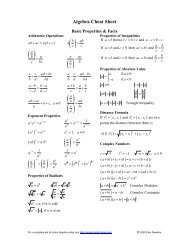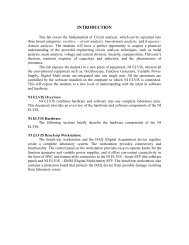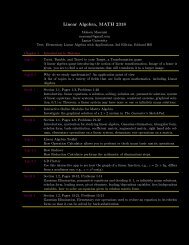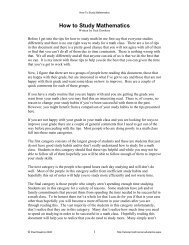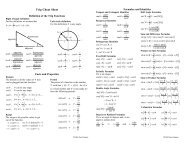Algebra/Trig Review - Pauls Online Math Notes - Lamar University
Algebra/Trig Review - Pauls Online Math Notes - Lamar University
Algebra/Trig Review - Pauls Online Math Notes - Lamar University
You also want an ePaper? Increase the reach of your titles
YUMPU automatically turns print PDFs into web optimized ePapers that Google loves.
<strong>Algebra</strong>/<strong>Trig</strong> <strong>Review</strong>This is not the set of solutions because we are NOT looking for values of x for which33sin ( x ) = − , but instead we are looking for values of x for which sin ( 5x ) = − .22Note the difference in the arguments of the sine function! One is x and the other is5x . This makes all the difference in the world in finding the solution! Therefore, theset of solutions is4π5x= + 2 π n, n= 0, ± 1, ± 2, 35π5x= + 2 π n, n= 0, ± 1, ± 2, 3Well, actually, that’s not quite the solution. We are looking for values of x so divideeverything by 5 to get.4π2πnx= + , n= 0, ± 1, ± 2, 15 5π 2πnx= + , n= 0, ± 1, ± 2, 3 5Notice that I also divided the 2πn by 5 as well! This is important! If you don’t dothat you WILL miss solutions. For instance, take n = 1.4π 2π 10π 2π ⎛ ⎛2π ⎞⎞⎛10π⎞ 3x = + = = ⇒ sin 5 sin15 5 15 3⎜ ⎜ ⎟3⎟= ⎜ ⎟=−⎝ ⎝ ⎠⎠⎝ 3 ⎠ 2π 2π 11π ⎛ ⎛11π ⎞⎞⎛11π⎞ 3x = + = ⇒ sin 5 sin3 5 15⎜ ⎜ ⎟ = =−15⎟ ⎜ ⎟⎝ ⎝ ⎠⎠⎝ 3 ⎠ 2I’ll leave it to you to verify my work showing they are solutions. However it makesthe point. If you didn’t divided the 2πn by 5 you would have missed these solutions!4. 2sin ( 5x + 4)=− 3SolutionThis problem is almost identical to the previous problem except this time we have anargument of 5x + 4 instead of 5x . However, most of the problem is identical. In thiscase the solutions we get will be4π5x+ 4 = + 2 π n, n= 0, ± 1, ± 2, 35π5x+ 4 = + 2 π n, n= 0, ± 1, ± 2, 3Notice the difference in the left hand sides between this solution and thecorresponding solution in the previous problem.Now we need to solve for x. We’ll first subtract 4 from both sides then divide by 5 toget the following solution.© 2006 Paul Dawkins 66http://tutorial.math.lamar.edu/terms.aspx


